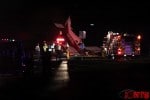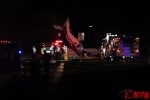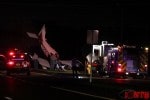
NTSB: Pilot’s Fuel Planning Abilities Likely Affected by Cocaine in 2014 Safety Harbor Crash
Posted: January 5, 2016
The National Transportation Safety Board (NTSB) has recently released a factual and probable cause report regarding the crash that occurred on March 22, 2014. The conclusion was the pilot’s fuel planning abilities likely affected by cocaine.
The crash instantly killed the 53 year-old pilot, Jeffrey Bronken, and his 15 year-old daughter, Katherine Bronken, 4 days later. The daughter’s friend and sole survivor of the crash, 15 year-old Keyana Linbo, returned home to Illinois about 1 week after the crash.
The NTSB report concluded that the airplane had been flying for 4 hours and 21 minutes and was about 6 miles from St. Pete Clearwater Airport (PIE) when the pilot reported a fuel emergency to air traffic control.
AUDIO from Tampa International Tower (Source: LiveATC.net)
Click below to play
All gaps have been removed from the audio recording
The aircraft held 48 usable gallons of fuel and consumed about 10.5 gallons per hour, resulting in an expected endurance of 4 hours and 35 minutes which does not account for fuel used during taxi, takeoff, and climb.
The airplane collided with an 160 foot tall power line that crossed McMullen Booth Road after the pilot declared his intention to land on the roadway due to the fuel emergency.
Multiple calls were received by the Pinellas County Regional 911 center on the morning of March 22, 2014 at about 4 AM of a plane down after hitting power lines.
Witnesses reported that the male occupant of the aircraft was lying in the roadway with two injured females still inside.
Initial arriving units reported locating an aircraft nose first into the ground. The plane was a Single-engine Piper aircraft which left Chicago, Illinois about 6:30pm the night prior. It was enroute to St. Petersburg-Clearwater Airport. The Piper PA-28-181 Archer aircraft was placed into service in 1980 and registered to Inman Glass Corporation out of Highland Park, Illinois.
The preliminary report indicated that the aircraft was substantially damaged when it collided with powerlines. Night visual meteorological conditions prevailed and no flight plan was filed for the planned flight to PIE. The flight departed John C Tune Airport (JWN), Nashville, Tennessee about 11:38 PM after being completely fueled with 44 gallons of aviation gasoline.
The wreckage came to rest upright, nose-down, oriented on a southeasterly heading, on a highway beneath the powerlines. All major components of the airplane were accounted for at the scene. The engine and cockpit area were crushed inward and the cabin roof had separated. The cabin roof, where the top of the cockpit door met the cabin, exhibited an impact mark consistent with a wire strike. The impact mark was a similar size to an approximate 1.25-inch-thick aluminum powerline that had separated during the impact, causing a power outage in the area. The aluminum power line had been located about 160 feet above the highway.
The leading edge of the left wing exhibited impact damage. The left main fuel tank remained intact and approximately 4 ounces of fuel were recovered from it by an FAA inspector. The left aileron and flap remained attached. The right wing was undamaged with the exception of a partial separation of the right flap and the right fuel tank was compromised at its fuel drain. During recovery, the FAA inspector observed some drops of fuel dripping from the right tank. The fuel selector was found positioned to the left main fuel tank.
The pilot held a private pilot certificate with a rating for airplane single-engine land. His most recent FAA second-class medical certificate was issued on October 31, 2013. At that time, he reported a total flight experience of 1,549 hours.
The autopsy was performed on Mr. Bronken at the District Six Medical Examiner’s Office in Largo, Florida on March 22, 2014. The cause of death was noted as blunt trauma.
Toxicology tests were performed by the FAA Civil Aerospace Medical Institute. The results indicated the presence of cocaine and many of its metabolites in multiple body fluids. The level of cocaine and presence of a particular metabolite in the body seemed to suggest that it was smoked “crack” in a time frame consistent with the trip that started in Illinois. Another metabolite that was detected is only present when cocaine and ethanol are ingested together, however, no ethanol levels were detected at the time of the autopsy.
The National Transportation Safety Board determines the probable cause(s) of this accident as follows: The pilot’s inadequate fuel planning, which resulted in a total loss of engine power due to fuel exhaustion. Contributing to this accident was the pilot’s impairment due to cocaine use.
Images
Video (click below to play)
[mappress mapid=”155″]
© 2014 IONTB.COM
Images
© 2016 IONTB.COM





































